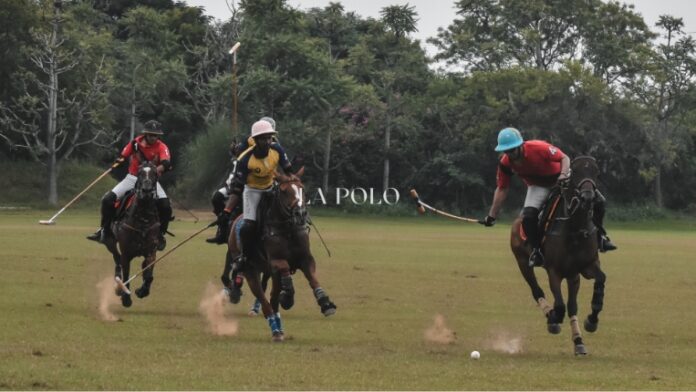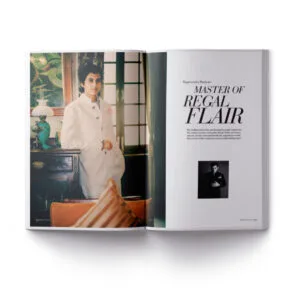THE RULES OF THE GAME Polo is played by two four-player teams on a grass field that measures 275 meters by 145 meters, equal to five soccer fields combined. Players on horseback use long-handled mallets to control the ball, and a goal is scored when the ball passes through the goalposts at either end of the field. Each team is made up of an attacker, a defender, an offensive midfielder and a defensive midfielder. A match is composed of four to six (or eight, in Palermo, Buenos Aires) seven-and-a-half-minute periods called chukkers. Players change horses each chukker, and teams change ends of the field after a goal is scored. A player who hits the ball is considered to have the right of way along the line of the ball’s trajectory. To avoid collisions, each player has access to the ball only from a parallel line. The most common foul is “crossing the line.” The referees impose a penalty based on the infraction committed, usually a free shot for the opposing team.
In Argentina, polo is more than a simple sport. It is a way of life which goes back generations. Argentina should be the beginning of any polo enthusiast’s journey. Nowadays, the three best international polo tournaments are played here and known as the Triple Crown: Tortugas, Hurlingham and the Palermo Open. In the inner sanctum of polo, at the heart of the Palermo stadium, the games are a veritable ballet of centaurs; accelerations and brakings evoke a rhythm. Up to ten horses per polo player are used in Palermo! Exclusively speedsters pampered by a devoted personnel: petiseros [lads], veterinarians, trainers, paramedics. . . . The aficionados of the sport know the names of each of the mounts! The most famous polo horsebreaker/horse whisperer in Argentina, Polito Ulloa, “My training [of horses] is traditional: a mix between the gaucho and Indian techniques. You need to be patient and understand the horse’s secret language. For polo, a horse needs to master slowing down, as well as be able to repeat turns and accelerations in succession. It must understand its surroundings with accuracy and remain sharp, serene and calm. It must also be brave, resistant, dedicated. . . . The key? That it knows to await your order and responds as an extension of your body upon it.”
Polo Is Passion! A timeless Horsemen Epic, originating in Persia, Tibet and on the steppes of Mongolia and China, reaching into India and the United Kingdom, growing throughout Argentina, the United States and far beyond. It’s passed down from generation to generation, as a crucial part of your DNA that you simply cannot live without. All your family traveling with you around the world for the international tournaments—A Grand Tour. Polo flows in your veins, is the King of your Heart, and the rhythm of your stride. Horses become your obsession. A devotion, an adoration. Polo aficionados talk only about horses, live surrounded by horses and dream only of horses. They take on the role of ultimate progenitor, performing complex manipulations on elite embryos and even cloning processes to produce the ideal cavalry ! You become the extension of your horse and vice versa. You need high doses of adrenaline, crave both absolute freedom and intense pressure, have a fierce determination to excel and conquer, as part of a brotherhood. And let’s not forget the innate sense of style, timeless elegance and a je ne sais quoi that reflect a sophisticated, cosmopolitan life. A positive addiction beyond frontiers.
Member of Chitral’s oldest and most illustrious polo dynasty; founder, Hindukush Heights, In Hindu Kush, Prince Siraj ul-Mulk, “the highlight of the polo season is the Shandur Polo Festival, held in the beginning of July, in which Chitral meets archrival Gilgit at the picturesque Shandur Pass—the highest polo grounds on Earth. The evening before the games, a local band performs the traditional opening-ceremony song. Even the horses recognize this wild minstrelsy. It is quite a treat to watch them prick their ears and paw the ground upon hearing the melody. At the beginning of a game, the teams line up on opposite sides of the central line. Each player holds a mallet in his right hand, and a chabuk, or whip, dangles from his left wrist. The band kicks in again, the ball is thrown and the battle is on.” The princely stables built by Louis-Henri de Bourbon, Prince of Condé, at the Museum of the Horse in Chantilly. According to legend, he believed he would be reincarnated as a horse and would thus benefit from precious stables. The horse wears a balaclava, a Guibert blanket made of breathable, warming Thermatex, and a leather bridle and reins from Hermès…






